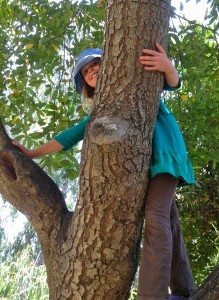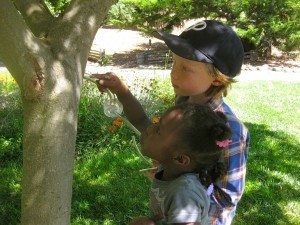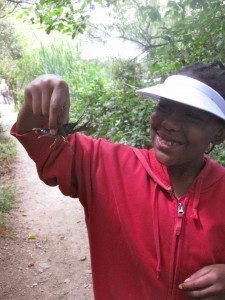Birds, bugs and happy Audubon campers
By Marissa Ortega-Welch
This month we ran the first-ever Golden Gate Bird Alliance “Wildlife Discoverers” summer camp for children. As I sit here going through all the photos from our week, I am struck by what a truly amazing time it was.
We really couldn’t have asked for a better group of campers. The kids ranged in age from six to ten and came from all over the East Bay and from all walks of life – some were there on scholarship thanks to generous donations from Audubon members, and some were there from private schools. But what they all had in common was a profound interest in exploring, up close and personal, the natural world.
GGBA Education Director Anthony DeCicco and I had armed ourselves with an arsenal of activities, games, and stories in anticipation of what we thought would be the inherent squirrelly nature of the average eight-year-old. But from the very first morning, it became clear that all these activities would not be necessary.

Our first day began at Arrowhead Marsh, where we handed out “field journals” to all the campers for use throughout the week taking notes and drawing the species we saw. Before we could even get to our first activity, a Great Blue Heron flew into the grass near us and some of the campers wanted to look at it through the scope. Meanwhile, a cotton-tailed rabbit ran into the bushes and some other campers wanted to identify the species. California ground squirrels were popping up all around us. Before I knew it, all of the youth were sitting on the ground, capturing what we’d seen in words and pictures in their field journal. And it wasn’t even ten a.m. on the first day.
The same thing happened on the day of our big hike in Joaquin Miller Park. We met at the ranger station and — equipped with binoculars, our bug catchers, field guides and lots of water — we hiked up the Big Trees Trail to the redwood forest. It was a hot day but the shade of the descendents of some of the oldest trees in California kept us cool. Again, Anthony and I were ready with a whole list of activities, but right after lunch the kids instinctively started turning over logs and looking for decomposers, and suddenly we knew that our afternoon wouldn’t go quite as planned. We found California slender salamanders, millipedes and centipedes, and the students allowed the bugs to climb all over their arms.

In David Sobel’s article “Look, Don’t Touch” in the most recent Orion magazine, he states:
“Between the ages of six and twelve, children have an innate desire to explore the woods, build forts, make potions from wild berries, dig to China, and each of these activities is an organic, natural way for them to develop environmental values and behaviors.”
Thankfully, our all-day week-long summer camp provided us with plenty of time to allow the children to follow their innate desire to explore. As an educator, it was good for me to remember how very important the tactile exploration of nature is for children.
Another example of this was when we were on a midday bird walk in Alvarado Park. Energy was waning and the birds were quiet. But then we found blackberry bushes. Perfect. Now this was what we had energy for – experiencing nature through our taste buds! Later in the afternoon, the students’ interest in birds picked up again when we had the opportunity to touch and dissect owl Barn Owl pellets, extracting ribs, vertebrae and even a few fully intact skulls of pocket gophers from amongst the furry hard pellets that the owl coughed up.

Another camp day took us to Lake Merritt where the highlight for all was going out on pedal boats into the lake. With our boats, we were able to bird up close – sneaking up on Brown Pelicans resting on the buoys and Double Crested Cormorants nesting on the bird islands.

It was a beautiful day, verging on too hot. As we pedaled back to the dock, thoughts turned to ice cream. There’s nothing happier than a group of six- to ten-year-olds eating popsicles after a boat ride on a summer day.
That is, until you help them build bug vacuums and set them loose in the Botanical Gardens to catch and release bugs! These “aspirators,” as they’re called by bug collectors, operate with two hoses — one that you point at the bug and the other that you suck like a straw, creating a vacuum effect that pulls the bug into a holding container. And voila – you’ve caught a bug.

Our final day of camp was a cloudy one at Lake Temescal. The cooler weather didn’t keep the campers from wanting to go swimming. But not before catching crawdads in the lake with our homemade crawdad poles and hot dog bait.


At the end of the day, I sat on the beach and watched as the campers splashed and played together in the lake, surrounded by redwoods and Violet-Green Swallows circling overhead. It had been a great week, the kind of summer experience I would wish for every child and, really, every adult – time to explore, to dig our hands in the soil, to uncover bugs, to lie on the ground and look up at the tree tops.
All the planning in the world wouldn’t have caused that Great Blue Heron to fly towards us on our first morning, that Red-Tailed Hawk to fly overhead when Saul wanted to see a hawk so badly, or for the bat rays to appear in the creek right when Cyrus was on the bridge.
But when these things happened, we were ready – ready to explore with all our senses and ready to be wowed by the magic of nature.

—————————
Marissa Ortega-Welch is Environmental Education Program Coordinator for Golden Gate Bird Alliance. Before coming to GGBA, Marissa taught environmental education at the Olympic Park Institute in Washington state and conducted bird surveys in northwest national parks for the Institute for Bird Populations.
